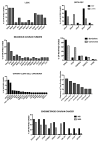Ovarian Cancers: Genetic Abnormalities, Tumor Heterogeneity and Progression, Clonal Evolution and Cancer Stem Cells
- PMID: 29389895
- PMCID: PMC5874581
- DOI: 10.3390/medicines5010016
Ovarian Cancers: Genetic Abnormalities, Tumor Heterogeneity and Progression, Clonal Evolution and Cancer Stem Cells
Abstract
Four main histological subtypes of ovarian cancer exist: serous (the most frequent), endometrioid, mucinous and clear cell; in each subtype, low and high grade. The large majority of ovarian cancers are diagnosed as high-grade serous ovarian cancers (HGS-OvCas). TP53 is the most frequently mutated gene in HGS-OvCas; about 50% of these tumors displayed defective homologous recombination due to germline and somatic BRCA mutations, epigenetic inactivation of BRCA and abnormalities of DNA repair genes; somatic copy number alterations are frequent in these tumors and some of them are associated with prognosis; defective NOTCH, RAS/MEK, PI3K and FOXM1 pathway signaling is frequent. Other histological subtypes were characterized by a different mutational spectrum: LGS-OvCas have increased frequency of BRAF and RAS mutations; mucinous cancers have mutation in ARID1A, PIK3CA, PTEN, CTNNB1 and RAS. Intensive research was focused to characterize ovarian cancer stem cells, based on positivity for some markers, including CD133, CD44, CD117, CD24, EpCAM, LY6A, ALDH1. Ovarian cancer cells have an intrinsic plasticity, thus explaining that in a single tumor more than one cell subpopulation, may exhibit tumor-initiating capacity. The improvements in our understanding of the molecular and cellular basis of ovarian cancers should lead to more efficacious treatments.
Keywords: cancer stem cells; chemoresistance; clonal evolution; genetic alterations; metastases; ovarian cancer.
Conflict of interest statement
The authors declare no conflict of interest.
Figures


References
-
- Jamal A., Siegel R., Xu J., Ward E. Cancer statistics. CA Cancer J. Clin. 2010;60:277–300. - PubMed
Publication types
LinkOut - more resources
Full Text Sources
Other Literature Sources
Research Materials
Miscellaneous

